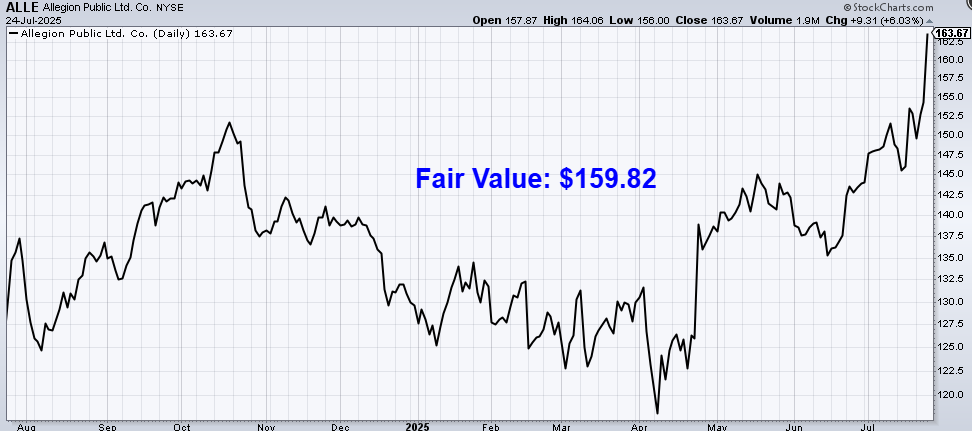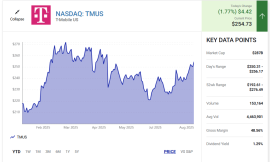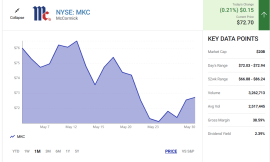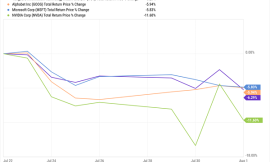The news and noise is endless.
Tariffs, the Fed, interest rates, geopolitics, etc.
If you follow this stuff closely, you’d be a basket case and never feel comfortable enough to invest money.
That’s why the best advice is simple.
Ignore the noise!
Think about the long term, because investing really is all about long-term outcomes (whereas short-term speculation is a totally different animal).
And when one’s mind is on the long pull, short-term headlines fade from view and become irrelevant.
This kind of mindset is easy to adopt when one follows the dividend growth investing strategy.
That’s a long-term investment strategy that involves buying and holding shares in high-quality businesses showering shareholders with steadily rising cash dividend payments.
You can find hundreds of such businesses by looking over the Dividend Champions, Contenders, and Challengers list, a treasure trove of information on US-listed stocks that have raised dividends each year for at least the last five consecutive years.
These businesses are so ripe for long-term investment because they consistently do things the right way, year after year, over the long run, as partially evidenced by those lengthy track records of increasing cash dividends.
I instituted this strategy for my own money years ago, using it as the framework for the FIRE Fund – my real-money portfolio that generates enough five-figure passive dividend income for me to live off of.
This has actually been enough for me to live off of since I quit my job and retired in my early 30s.
How I was able to accomplish that feat was detailed in my Early Retirement Blueprint.
While ignoring the noise is advisable, ignoring valuations is not.
That’s because price only tells you what you pay, but value tells you what you get.
An undervalued dividend growth stock should provide a higher yield, greater long-term total return potential, and reduced risk.
This is relative to what the same stock might otherwise provide if it were fairly valued or overvalued.
Price and yield are inversely correlated. All else equal, a lower price will result in a higher yield.
That higher yield correlates to greater long-term total return potential.
This is because total return is simply the total income earned from an investment – capital gain plus investment income – over a period of time.
Prospective investment income is boosted by the higher yield.
But capital gain is also given a possible boost via the “upside” between a lower price paid and higher estimated intrinsic value.
And that’s on top of whatever capital gain would ordinarily come about as a quality company naturally becomes worth more over time.
These dynamics should reduce risk.
Undervaluation introduces a margin of safety.
This is a “buffer” that protects the investor against unforeseen issues that could detrimentally lessen a company’s fair value.
It’s protection against the possible downside.
Ignoring the noise and routinely buying undervalued high-quality dividend growth stocks through a long-term investment plan can lead to tremendous wealth, passive income, options, and freedom in life.
All that said, recognizing undervaluation requires one to already understand the ins and outs of valuation.
Well, that’s where Lesson 11: Valuation comes in.
Written by fellow contributor Dave Van Knapp, it explains what valuation is and how to go about confidently estimating the fair value of just about any dividend growth stock out there.
With all of this in mind, let’s take a look at a high-quality dividend growth stock that appears to be undervalued right now…
Allegion PLC (ALLE)
Allegion PLC (ALLE) is an American (but Irish-domiciled) provider of security products for homes and businesses globally.
Founded in 1908, but positioned as an independent company after being spun off from Ingersoll Rand Inc. (IR) in 2014, Allegion is now a $13 billion (by market cap) security competitor that employs over 14,000 people.
Allegion reports results across two geographic segments: Allegion Americas, 80% of FY 2024 revenue; and Allegion International, 20%.
Nonresidential markets account for 75% of sales, while the remaining 25% relates to residential.
The company produces and sells a number of security-related products and accessories, including: access control systems, door closers, exit devices, electronic security products, locks, and key systems.
These products are sold under a range of leading brands, including: CISA, Interflex, LCN, Schlage, SimonsVoss, and Von Duprin.
Based on Maslow’s Hierarchy of Needs, safety is of paramount need for humans, eclipsed only by basic survival needs (such as food and water).
In a world in which crime and danger are perceived (rightly or wrongly) to be more prevalent than at other times in the recent past, perhaps due to widespread social issues such as homelessness and drug addiction, products and services designed to improve safety are in high demand.
That plays right into the hands of Allegion, which supplies the market with safety-first solutions designed to make lives, buildings, and valuables more secure.
Unfortunately, we cannot rely on common trust and human decency; homes and businesses cannot be be left unsecured.
This leads to secular demand for Allegion’s portfolio of products.
Moreover, that structural demand is given an extra boost by technology, as high-tech security solutions (such as electronic locking systems) are more advanced and effective than many analog alternatives.
This additional effectiveness comes at higher costs, which opens the door for higher revenue and profit for Allegion over time.
Moreover, relating to tech advances, data centers, which are popping up everywhere, require high-tech security solutions of their own.
This builds on what is already an impressive track record for rising revenue and profit, which has allowed Allegion to reliably grow its dividend to shareholders.
Dividend Growth, Growth Rate, Payout Ratio and Yield
To that point, Allegion has increased its dividend for 12 consecutive years.
Its 10-year dividend growth rate of 19.6% is incredible, but some of that was fueled by an expansion of the payout ratio (off of a very low base after the spin-off).
More recent dividend raises have been in a high-single-digit range.
Still very solid dividend growth here, but expecting indefinite ~20% dividend growth out of Allegion would be inappropriate.
The stock’s 1.4% yield is respectable and beats the broader market, and it’s 10 basis points higher than its own five-year average.
There’s an above-average yield (in more ways than one) to be had here, even if it’s not as generous as what one can get in other areas of the market.
With a payout ratio of 28.7%, even after brisk dividend growth for much of the last decade, the dividend remains extremely secure (which is fitting for a company that aims to make the world more secure).
Although this stock might not be a top candidate for income investors, long-term dividend growth investors who gravitate toward high-quality, durable compounders (this stock has compounded at a double-digit annualized rate over the last decade, including reinvested dividends) will likely see much to like.
Revenue and Earnings Growth
As much as there may be to like, though, many of the dividend metrics above are based on what’s happened in the past.
However, investors must always be looking toward the future, as today’s capital gets risked for tomorrow’s rewards.
As such, I’ll now build out a forward-looking growth trajectory for the business, which will be of great use when the time comes later to estimate fair value.
I’ll first show you what the business has done over the last decade in terms of its top-line and bottom-line growth.
I’ll then reveal a professional prognostication for near-term profit growth.
Lining up the proven past with a future forecast in this way should give us the information we need to make an educated call on where the business could be going from here.
Allegion advanced its revenue from $2.1 billion in FY 2015 to $3.8 billion in FY 2024.
That’s a compound annual growth rate of 6.8%.
Really good stuff.
I usually look for mid-single-digit (or better) top-line growth out of a mature business, and Allegion more than lived up to expectations.
Meanwhile, earnings per share grew from $1.59 to $6.82 over this period, which is a CAGR of 17.8%.
Impressive.
We can now see that double-digit dividend growth largely came from double-digit EPS growth, showing control and prudence by management.
This is the kind of bottom-line growth you might expect out of a tech company, which makes it all the more impressive, but one might argue that Allegion is a tech company in a way, just in the sense that security products are becoming more technological in their build, deployment, and usage.
Excess bottom-line growth was driven by margin expansion and buybacks, with the outstanding share count down by nearly 10% over the last decade.
Looking forward, CFRA is projecting a 7% CAGR for Allegion’s EPS over the next three years.
This would represent a material slowdown relative to what Allegion has done since being spun out.
Although some of the growth out of the last decade was back loaded, even FY 2024 showed 11.4% YOY EPS growth.
Notably, when I last analyzed Allegion earlier this year, CFRA’s three-year projection was sitting at 12%.
I’m not quite sure what accounts for the dramatic shift, but I’d be more inclined to to rely on the earlier forecast.
From what I can tell, CFRA remains enthusiastic.
This passage from CFRA seems to spell it out: “We see [Allegion] benefiting from increased focus on safety/security in healthcare, hospitality and education. Data center construction growth (+22% in 2025, +14% in 2026) provides additional tailwinds. Strong cash flow generation adds to our positive view, with Q1 cash from operations +104% Y/Y and FCF +248% Y/Y.”
With gushing prose like that, I’m not sure where the 7% forecast comes from.
Nonetheless, again, I think there’s much to be excited about from Allegion.
We have the core need/demand for security, and then there are upgrade cycles (the average age of commercial buildings in the US is more than 50 years old) and favorable changes in tech on top of it.
The most recent year out of Allegion is a pretty good starting point for growth expectations, in my view.
That points to low-double-digit business and dividend growth, and you get to start off with the market-beating 1.4% yield.
It’s a recipe for a low-double-digit annualized total return out of the stock, which is something the stock has been reliably good for right out of the gate.
I see more of the same coming, and the same has been quite good.
Financial Position
Moving over to the balance sheet, Allegion has a decent financial position.
The long-term debt/equity ratio is 1.3, while the interest coverage ratio is approximately 8.
S&P gives Allegion an investment-grade credit rating of BBB.
These are “okay” numbers for me.
The balance sheet is, for me, the one chink in the armor; otherwise, Allegion has a terrific business on its hands.
Allegion is actively acquisitive, which explains the balance sheet, but these acquisitions have proven to largely be accretive and a great use of capital.
Profitability for the firm is outstanding.
Return on equity has averaged 48.9% over the last five years, while net margin has averaged 14.6%.
ROE gets a boost from the balance sheet, but even ROIC is routinely coming in at about 20%.
It’s clear that Allegion is generating high returns on capital, which is a hallmark of a great business.
Overall, Allegion has much to like and very little to dislike.
And with economies of scale, brand recognition, a built-out distribution network, and a large installed base which leads to “stickiness” and recurring revenue, the company does benefit from durable competitive advantages.
Of course, there are risks to consider.
Litigation, regulation, and competition are omnipresent risks in every industry.
Competition, in particular, is an issue, as Allegion faces formidable competitors in this space (such as Assa Abloy AB (ASAZY)).
Around half of the company’s revenue is tied to new construction, exposing the company to the associated risks (including interest rates, macroeconomics, new construction demand, labor shortages, etc.).
Being an international company, Allegion faces geopolitics, supply chain concerns, and currency exchange rates, but the company’s heavy domestic tilt mitigates most of this.
The industry is increasingly moving toward digital/automated solutions, which means Allegion must continually stay ahead of the tech curve in order to not get left behind.
I don’t find these risks anywhere near insurmountable.
And with the valuation being as undemanding as it is, it’s also far from insurmountable…
Valuation
The stock is available for a P/E ratio of 21.7.
That’s below both the broader market’s earnings multiple.
It’s also lower than the stock’s own five-year average P/E ratio of 22.5.
The P/CF ratio of 18.4, which is not high at all, is slightly below its own five-year average of 18.6.
And the yield, as noted earlier, is higher than its own five-year average.
So the stock looks cheap when looking at basic valuation metrics. But how cheap might it be? What would a rational estimate of intrinsic value look like?
I valued shares using a two-stage dividend discount model analysis.
I factored in a 10% discount rate, a 10-year dividend growth rate of 12%, and a long-term dividend growth rate of 7.5%.
This is very close to the same model I’ve used in the past for Allegion, and I still find it appropriate to stick with it.
I’m basically assuming more near-term low-double-digit dividend growth, supported by like EPS growth that has recently been demonstrated out of the company.
A shift into a high-single-digit growth profile is assumed to shake out thereafter, which seems pretty realistic for a business of Allegion’s caliber, capabilities, and end market opportunities.
I don’t think I’m reaching here.
If anything, Allegion has a good chance of outperforming my expectations.
The DDM analysis gives me a fair value of $154.47.
The reason I use a dividend discount model analysis is because a business is ultimately equal to the sum of all the future cash flow it can provide.
The DDM analysis is a tailored version of the discounted cash flow model analysis, as it simply substitutes dividends and dividend growth for cash flow and growth.
It then discounts those future dividends back to the present day, to account for the time value of money since a dollar tomorrow is not worth the same amount as a dollar today.
I find it to be a fairly accurate way to value dividend growth stocks.
From my viewpoint, the stock appears, at worst, to be fairly valued.
But we’ll now compare that valuation with where two professional stock analysis firms have come out at.
This adds balance, depth, and perspective to our conclusion.
Morningstar, a leading and well-respected stock analysis firm, rates stocks on a 5-star system.
1 star would mean a stock is substantially overvalued; 5 stars would mean a stock is substantially undervalued. 3 stars would indicate roughly fair value.
Morningstar rates ALLE as a 4-star stock, with a fair value estimate of $162.00.
CFRA is another professional analysis firm, and I like to compare my valuation opinion to theirs to see if I’m out of line.
They similarly rate stocks on a 1-5 star scale, with 1 star meaning a stock is a strong sell and 5 stars meaning a stock is a strong buy. 3 stars is a hold.
CFRA rates ALLE as a 4-star “BUY”, with a 12-month target price of $163.00.
We have a fairly tight range this time around. Averaging the three numbers out gives us a final valuation of $159.82, which would indicate the stock is possibly 3% undervalued.
Bottom line: Allegion PLC (ALLE) is a high-quality company benefiting from secular demand for products which make lives and belongings more secure in a very insecure world. With a market-beating yield, double-digit dividend growth, a low payout ratio, more than 10 consecutive years of dividend increases, and the potential that shares are 3% undervalued, long-term dividend growth investors who gravitate toward durable compounders ought to take a good look at this name.
-Jason Fieber
Note from D&I: How safe is ALLE’s dividend? We ran the stock through Simply Safe Dividends, and as we go to press, its Dividend Safety Score is 61. Dividend Safety Scores range from 0 to 100. A score of 50 is average, 75 or higher is excellent, and 25 or lower is weak. With this in mind, ALLE’s dividend appears Safe with an unlikely risk of being cut. Learn more about Dividend Safety Scores here.
P.S. If you’d like access to my entire six-figure dividend growth stock portfolio, as well as stock trades I make with my own money, I’ve made all of that available exclusively through Patreon.
How To Collect Up To 69% Yields From ZERO-Dividend Stocks [sponsor]
Did you know some tech giants pay little to no dividends? A NEW investment lets you collect up to 69.87% yields from these very stocks — without options trading! Click here to learn how to potentially collect $84,160 per year.
Disclosure: I have no position in ALLE.




